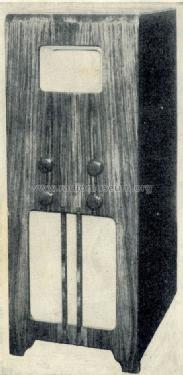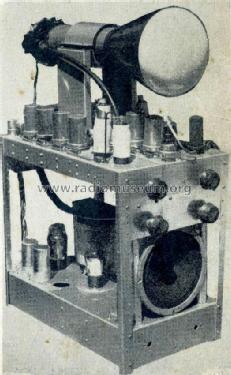- Country
- Great Britain (UK)
- Manufacturer / Brand
- Premier Radio Co. Ltd. (B. H. Morris & Co. (Radio) Ltd.); London
- Year
- 1948 ?
- Category
- Television Receiver (TV) or Monitor
- Radiomuseum.org ID
- 111117
- Number of Tubes
- 20
- Valves / Tubes
- EF50 EF50 EF50 SP61 SP61 EA50 EA50 EF50 EF50 EBC33 6V6 SP61 SP61 SP61 SP61 SP61 SP61 VU39 VU39 VCR97
- Main principle
- TRF with diode detector
- Wave bands
- VHF incl. FM and/or UHF (see notes for details)
- Power type and voltage
- Alternating Current supply (AC) / 200-250 Volt
- Loudspeaker
- Permanent Magnet Dynamic (PDyn) Loudspeaker (moving coil) / Ø 6 inch = 15.2 cm
- Material
- Wooden case
- from Radiomuseum.org
- Model: Televisor - Premier Radio Co. Ltd. B. H.
- Shape
- Console, Lowboy (legs < 50 %).
- Dimensions (WHD)
- 11.25 x 29.5 x 18 inch / 286 x 749 x 457 mm
- Notes
- Self-build kit. An optional cabinet available. Available for either of the two 45 MHz TV transmissions at London or Birmingham. Upper sideband operation to simplify sound rejection. Probably the earliest TV kit available in the UK.
- Source of data
- - - Manufacturers Literature
- Author
- Model page created by Roy Johnson. See "Data change" for further contributors.
- Other Models
-
Here you find 24 models, 21 with images and 4 with schematics for wireless sets etc. In French: TSF for Télégraphie sans fil.
All listed radios etc. from Premier Radio Co. Ltd. (B. H. Morris & Co. (Radio) Ltd.); London
Forum contributions about this model: Premier Radio Co.: Televisor
Threads: 1 | Posts: 1
Televisor - Early TV viewing with own built Premier kit sets
An Australian RM.org guest visitor, Mr. Wells sent us his own experience with this kind of TV kit sets:
"It is with great pleasure that I saw the reference on your site to the Premier televisor.
My father(a grocer and gardiner!) built in 1948one of these when I was about 2 years old and the whole street watched the coronation on it in 1953. I still have the VCR97 (Picture tube) from it.
Sadly I do not still have the televisor ideed the parts were used in various radio projects during the early 60's. It's mains transformer powered my HF bands AM transmitter during the early days of my ham radio experience (G3RIN) then.
We lived in Reigate Surrey under the shadow of the north downs and received Alexandra Palace on a 2 element antenna mounted on the chimney. I remember we had a good clean noise free picture but I also remember theimpulse interference from cars on the sound and also makingspots on the picture.
Ours received Alexandra Palace with the vision tuned to 45MHz and the sound tuned to 41.5MHz (Channel 1). Also when it was sold Alexandra Palace sent out a double sideband transmission for which the televisor was designed. A small but very satisfactory retune was done when the change was made to vestigial sideband. As a little boy I can remember this being done.
Incidentally there were a number of commercially available televisions at the time, notably one 9 inch model from Pye, that were TRF models using EF50's. This was of course because there was only 'BBC" and initially I believe only 2 channels in use in band 1 (London restart ~1946 & Holmes Moss ~1949).
It should also be pointed out that the VCR97 produced a black and green picture. Our set also had an oil filled magnifier (Watch out for such a system here) that increased the 6 inch picture of the VCR97 to 9 inches. The VRC97 was a short persitence tube which was unusual at the time because most "war surplus" tubes were long persistence for radar use and useless for TV because the picture just smeared all over the screen during movement.
I still have 4 of the coil formers from the set. I had used them in various projects and somehow hang onto them.
The televisor actually started my interest in radio and electronics and led to a carrear in the electronics industry. At 12 years old I actually rebuilt the sound receiver of the televisor for Crystal Palace 41.5MHz but now all I have left is 4 coil formers. This project enabled me to get a secondary school transfer at age 13 to a technical school. (13+).
Although I am very well versed in modern day electronic design including digital processors, as a retired person I get more fun out of playing with old valve stuff. This includes restoring old radio's and building new one's in the old way.
I am currently building a 5 vale superhet with octal valves. Winding the coils and making the IF transformers has been a bit of a chalenge!
Regards Ray Wells"
(Thank you Mr Wells also for the 24 pages Premier booklet).
PS: Compare this notice with my earlier interview with a Premier Long Range Model (kit)buyer. (Partly written in German).
With feedbacks like this we are able to fill "just old stuff" with living memories for future generations!
Wolfgang Scheida, 15.May.12



